|
|
|
The Pacific
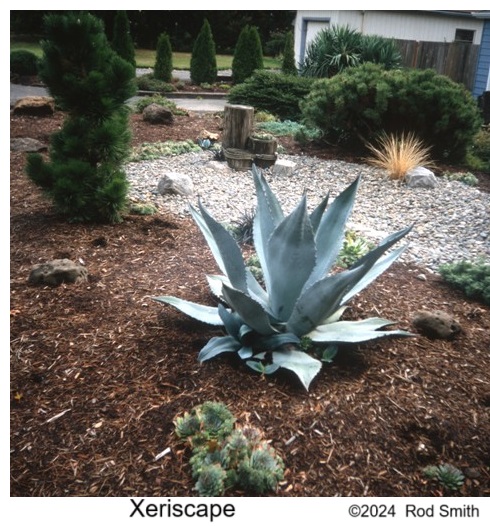 Northwest has an abundance of rain during the winter, but summers are usually dry when plants need the most water. Portland averages
five to seven inches of rain per month in the winter, but less than one inch in July and August. Daily water usage almost doubles during the summer
months. The largest part of that summer increase goes to water lawns and landscapes.
Northwest has an abundance of rain during the winter, but summers are usually dry when plants need the most water. Portland averages
five to seven inches of rain per month in the winter, but less than one inch in July and August. Daily water usage almost doubles during the summer
months. The largest part of that summer increase goes to water lawns and landscapes.
The goal of Water Wise Gardening is to conserve water by using it efficiently. But it is not necessary to go the extreme of planting a Xeriscape with only plants that never need watering. An attractive, low water landscape can be created by using Water Wise principles and practices.
Basic Steps to Efficient Water Use
1 Reduce water use for lawn areas.
2 Improve soil for better aeration and drainage.
3 Study the yard for microclimates: sun, shade,
warm, cool, wet, dry.
4 Choose plants that need less water and
group them by water needs.
5 Water wisely with the minimum needed.
6 Conserve water with mulches.
7 Maintain irrigation system and remove weeds.
 require about an inch of water each week when temperatures stay below 80 degrees, or 1.5 inches above 85 degrees. Applying a half inch of water two
or three times a week is much better than applying a small amount every day. Deep watering encourages a deeper root system which can draw water
from a larger soil volume. For more information on lawns, see Lawn Care.
require about an inch of water each week when temperatures stay below 80 degrees, or 1.5 inches above 85 degrees. Applying a half inch of water two
or three times a week is much better than applying a small amount every day. Deep watering encourages a deeper root system which can draw water
from a larger soil volume. For more information on lawns, see Lawn Care.
Eco-Lawns can save even more water. Most are a mixture of grasses, clovers, and flowering plants, such as, English Daisies, Roman Chamomile, Sweet Alyssum and Yarrow. Eco-Lawn seed mixes are available locally from Pro Time Lawn Seed in Portland, OR. Their Rough and Ready mix contains grasses and Micro-clover, but no flowers, so it resembles a conventional lawn. Eco-Lawns will stay green all summer with only an inch of water twice a month. I mow my Eco-Lawn three to four inches high every two weeks in the spring and fall and rarely mow it in the summer. Eco-Lawns need much less care than a manicured lawn, but they still can get unattractive if neglected. A big advantage is that clover roots support colonies of Rhizobium bacteria that can pull nitrogen out of the air and convert it to a form that plants can use. I have not fertilized my Eco-Lawn since I planted it in 2019 and it is always a healthy green color.
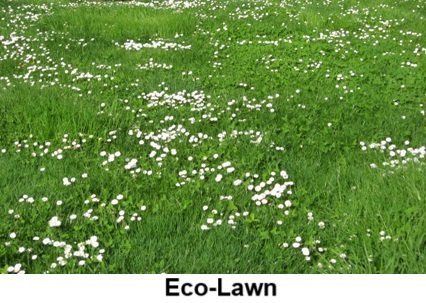 which need less water usually fall into two groups: plants from arid climates and plants
from Mediterranean climates which have dry
summers. Arid plants need less water year round, and include cactus, succulents, junipers, pines and some grasses. Dry summer plants grow and
flower in the fall, winter and spring and need little water during the summer. These include fall and spring flowering bulbs, Mediterranean heather,
brooms and native plants, such as Oregon grape and flowering currant. Lydia Broom is a low growing shrub that flowers in the spring. It loses its
leaves in the summer but the stems are green so it continues to look good.
which need less water usually fall into two groups: plants from arid climates and plants
from Mediterranean climates which have dry
summers. Arid plants need less water year round, and include cactus, succulents, junipers, pines and some grasses. Dry summer plants grow and
flower in the fall, winter and spring and need little water during the summer. These include fall and spring flowering bulbs, Mediterranean heather,
brooms and native plants, such as Oregon grape and flowering currant. Lydia Broom is a low growing shrub that flowers in the spring. It loses its
leaves in the summer but the stems are green so it continues to look good.
There are a few fruits that require less water. Apricots, figs, grapes, pineapple guavas, and pomegranates require little additional watering once
they are established. The other fruits and vegetables require regular watering through the summer. Some vegetables can get by with less water
because they can be planted in the spring or fall when there is natural rainfall. Broccoli, cabbage, cauliflower, lettuce, onions and peas will
grow well in cool weather. They can be planted as early as March. All but lettuce and peas can be planted as late as September. The cooler weather
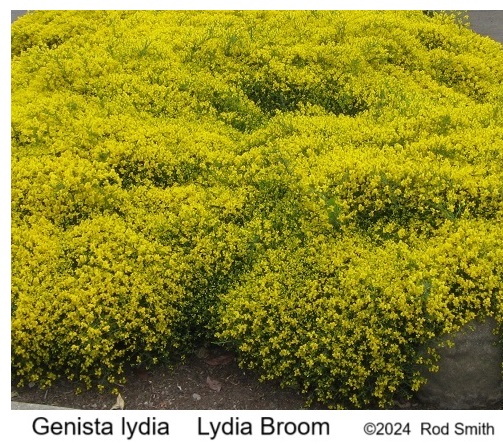 also encourages them to grow without going to seed (bolting).
also encourages them to grow without going to seed (bolting).
Soils in western Oregon might be sandy loam near rivers. Adding compost to sandy loam soil makes it hold more water and nutrients. However,
Washington County is mostly clay which prevents roots from growing deep because of a lack of oxygen deep in the soil. Adding compost and sand will
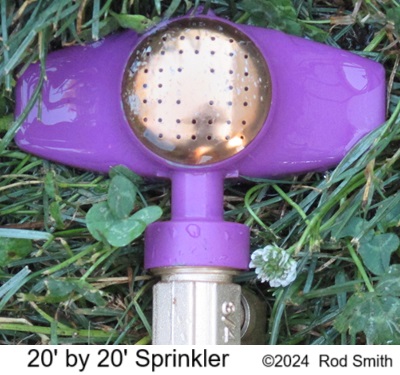 loosen clay soil and let oxygen penetrate deeper into soil. Sand should be concrete sand, not river sand, because concrete sand has sharp points
which hold the sand grains farther apart. Pumice is even better, because it is larger and has
air pockets which can hold moisture and nutrients. Profile Soil Conditioner is like a manufactured pumice. Potting soil which contains sand or
pumice is a good soil amendment if a small amount is needed. Large amounts can be purchased by the truckload from landscape supply yards. Amendments
should be dug or tilled into the top foot of soil. For more information on soil, see Improving Soil.
loosen clay soil and let oxygen penetrate deeper into soil. Sand should be concrete sand, not river sand, because concrete sand has sharp points
which hold the sand grains farther apart. Pumice is even better, because it is larger and has
air pockets which can hold moisture and nutrients. Profile Soil Conditioner is like a manufactured pumice. Potting soil which contains sand or
pumice is a good soil amendment if a small amount is needed. Large amounts can be purchased by the truckload from landscape supply yards. Amendments
should be dug or tilled into the top foot of soil. For more information on soil, see Improving Soil.
For most plants, the top inch of soil should be somewhat dry before it is watered again. Letting the soil dry before watering also prevents root rot and
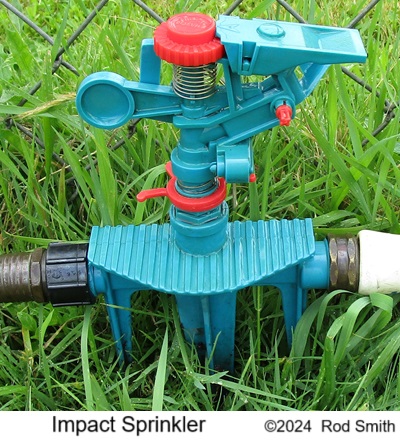 crown rot which are caused by keeping soil constantly soggy. This might take two days or two weeks, depending on the soil, the weather and the
number and size of plants. A screwdriver with a six inch long shaft is a good tool to check soil moisture because it will indicate soil moisture
deep in the root zone. Check the soil a few days after watering. If the screwdriver can easily be pushed in all the way to the handle, then the
soil is probably wetter than it needs to be. If it takes fair amount of pressure to push it in most of the way, that is probably the right amount
of soil moisture. If it can only be pushed in one inch, then the soil needs more water. A plant water meter is an even more accurate way to tell
when flowers, lawns, trees and shrubs need watering again because it can measure soil moisture at different depths.
crown rot which are caused by keeping soil constantly soggy. This might take two days or two weeks, depending on the soil, the weather and the
number and size of plants. A screwdriver with a six inch long shaft is a good tool to check soil moisture because it will indicate soil moisture
deep in the root zone. Check the soil a few days after watering. If the screwdriver can easily be pushed in all the way to the handle, then the
soil is probably wetter than it needs to be. If it takes fair amount of pressure to push it in most of the way, that is probably the right amount
of soil moisture. If it can only be pushed in one inch, then the soil needs more water. A plant water meter is an even more accurate way to tell
when flowers, lawns, trees and shrubs need watering again because it can measure soil moisture at different depths.
Several simple methods can be used to conserve water. A hose shut off on the end of a hose can save quite a bit of water. A watering wand will put water on the soil with less evaporation, not on leaves where it might encourage diseases. A water timer will automatically shut off hose end sprinklers. Battery powered water timers can turn the water on and off automatically.
A well designed irrigation system can end up saving water if it applies the water uniformly in the right amount. It will need to be adjusted through the season as average temperatures rise and fall. Water sensors can be added to irrigation controllers to automatically adjust watering. Rainfall sensors shut off the irrigation until rainwater has evaporated from the rain collector. Soil moisture sensors are even more accurate. With these sensors, irrigation controllers are set to run everyday, but the irrigation is skipped until the soil actually needs water.
Run
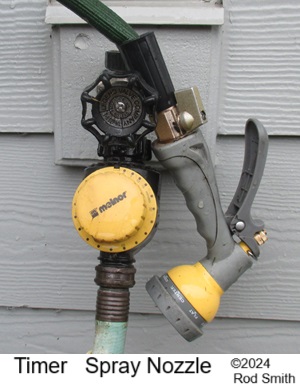 sprinklers at sunrise when the air is cool and there is less wind. Spread tuna cans around the yard to see how much water is being applied. Adjust or
replace sprinkler heads so water is applied evenly. Never apply more than one inch of water at a time to trees and shrubs, or more than a half-inch
on lawns and annuals.
sprinklers at sunrise when the air is cool and there is less wind. Spread tuna cans around the yard to see how much water is being applied. Adjust or
replace sprinkler heads so water is applied evenly. Never apply more than one inch of water at a time to trees and shrubs, or more than a half-inch
on lawns and annuals.
Drip irrigation is the most efficient way to water. It places water directly onto the soil so it does not evaporate into the air. It can apply different amounts of water to different areas according to the number of emitters. Also, it does not waste water on areas where only weeds grow. Drip irrigation systems are easy to design and install. Anyone who is handy at all can set up one. The drip system can be connected to a hose bib, or underground sprinkler systems can be converted to drip. Normally the half inch drip line is snaked through the landscape and emitters are inserted directly into the half inch drip line, or connected by a short length of quarter inch line. The drip lines can be buried but the emitters should be visible so they can be checked to see that they are not clogged.
Another way to save water is to capture rainfall and store it for later use. A good way to do this is to use a rain barrel to catch the water that falls on the roof. I cut one of the downspouts and used a section of flexible downspout to direct the water into my rain barrel. We use it exclusively for our house plants. Tap water is higher in chlorine content than is good for plants.
Rainfall can also be directed into a pond that is not waterproof on the sides. The water can soak into the surrounding soil to provide water for plants that need or tolerate wet soil.

Bark dust, compost, leaves, even newspaper can be used as mulch. But, decorative rock might increase water use because it transmits heat to the soil and reflects heat onto the plants. Black plastic is not good mulch because it does not let air or water soak in. Landscape fabric is better because it allows both water and air to move into the soil. Landscape fabric will also prevent perennial weeds from pushing up from the soil. However, it does not prevent weed seedlings from growing roots down through the fabric. Also, it interferes with earthworms which provide nutrients and aeration.
Mulching is also an effective way to conserve water in vegetable gardens. Newly planted seeds can be watered, then covered with damp newspaper. They will not need to be watered again until the seedlings emerge. Just be sure to remove the paper immediately when seedlings emerge so they do not overheat or mold. Mulch also prevents a crust from forming on the surface of the soil, which hinders seedling emergence. Plants planted close together act like a mulch by shading the soil and reducing weeds.
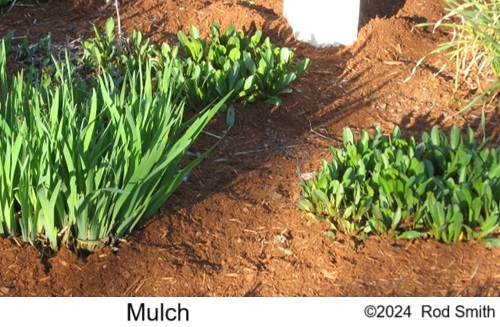
Any watering system should meet these basic requirements:
1. Apply water evenly.
2. Apply water slow enough that it soaks in, not runs off.
3. Apply water fast enough to finish in a reasonable time.
These features are desirable:
1. Apply a measured amount of water.
2. Start and stop automatically.
Hose end sprinklers usually are low cost and portable. They usually require setting up and taking down every time. A timer can be added to control amount and automatic start and stop.
Underground sprinklers are more expensive but permanent. They can be manual or automatic. They require more water pressure and volume but a well designed system can save water. Some companies that make sprinkler heads offer free design services. Installation requires a handyman. A plumbing permit and a backflow preventer are required. It is especially effective for lawns but not as much for trees and shrubs.
Drip irrigation
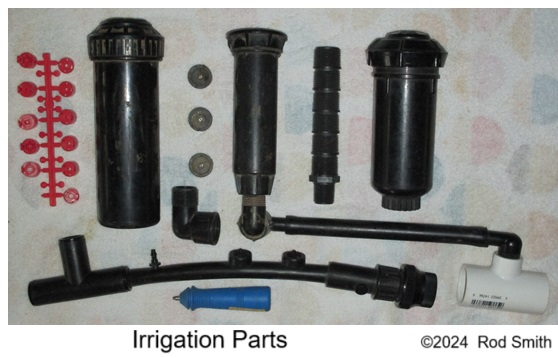 is easy to set up and to change. Most homeowners can do it themselves. It is by far the most water efficient. It can be manual or automatic. It is especially effective for trees and shrubs. One advantage is that by using different sizes and different numbers of drippers per plant, both low water and high water plants can get the right amount from the same water line.
is easy to set up and to change. Most homeowners can do it themselves. It is by far the most water efficient. It can be manual or automatic. It is especially effective for trees and shrubs. One advantage is that by using different sizes and different numbers of drippers per plant, both low water and high water plants can get the right amount from the same water line.
In the picture, the blue item at the bottom is the hole punch to punch holes in the 1/2 inch drip line just above it to insert drip emitters. Starting on the left end of the drip line is a Tee, a connector to connect a 1/4 inch drip line, two emitters, a drip line to hose thread adaptor and a vacuum breaker to prevent contaminated water from being sucked from the drip line back into the house water pipes.
Underground sprinkler types
In the picture starting at the top left corner is a set of different sized red plastic nozzles to fit in the gear driven sprinkler head to the right of it. Next is three different sized nozzles to fit in the fixed nozzle pop up sprinkler head to the right of them. Below them is a 1/2 inch street ell like the one to the right of it that connects the pop up sprinkler head to the swing joint, which is a length of flexible pipe with a 1/2 inch barb ell at each end. The barb ell on the right end is screwed into a Slip Slip Thread Tee for one inch pipe. The swing joint allows the sprinkler head to be placed exactly where it is needed and also prevents the PVC pipe from being broken if something hits the sprinkler head. Above the swing joint is a 1/2 inch by 3/4 inch cut off riser. The riser can be cut off so the top of the sprinkler head is even with the ground. To the right of the riser is another brand of gear driven sprinkler head.
Fixed nozzle sprinkler heads cover a 10' to 15’ radius. Different nozzles come in different shapes. Circles: 1/4, 1/3, 1/2, 2/3, 3/4, full, adjustable. Rectangles: 4X15’, 4X30’, 9X18’. They apply from 0.7 to 4 gallons per minute (gpm). An adjusting screw can reduce the spray distance and volume. Best for smaller areas and irregular shapes.
Gear driven heads cover a 15' to 35’ radius with single replaceable nozzles from 0.7 to 8 gpm. Spray arc is adjustable. Some brands have different heads for full circle or adjustable. Best for larger areas.
Try to use the fewest heads possible to cover the area. Start with the corners and space the sprinkler heads so each sprinkler head will barely spray to the next sprinkler head.
The most important design step is determining how many gallons per minute can be supplied which determines how many sprinkler heads can run at the same time. Turn on an outdoor faucet and time how long it takes to fill a bucket. For a 5 gallon bucket, calculate 5 gallons divided by number of seconds times 60 equals gallons per minute. 3/4” pipe will handle up to 10 gpm. 1” pipe up to 15 gpm. 1 1/4” pipe up to 20 gpm. 1 1/2” pipe up to 25 gpm.
For each valve, arrange the pipes with a header leading to laterals so all sprinkler heads have the same pressure. Every elbow, tee and sprinkler head will decrease the pressure to every sprinkler head beyond them if the pipe is not big enough.
Do not mix different types of sprinkler heads on the same valve because fixed nozzle sprinkler heads apply water much faster than gear driven sprinkler heads. Lawns should be on a separate valve from trees and shrubs. Shady areas might need to be on a different valve from sunny areas. Try to avoid spraying water on the house.
Install a flexible pipe to connect PVC pipe to the sprinkler head so the PVC pipe is not broken if something hits the sprinkler head.
When installing the sprinkler system, it is very important to flush the dirt out of the pipe before installing the valves and flush again before installing the sprinkler heads. You will probably need to start installing the sprinkler heads when the water runs clear to force water to the ends of the pipes.
Home Page
Site Map
Landscape Design
Lawn Care
Oregon Invasive Plants
Oregon Native Landscape Plants